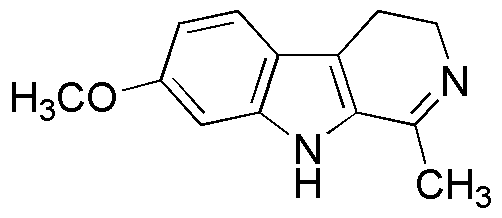Harmaline is widely utilized in research focused on:
- Neuroscience Research: Harmaline is studied for its potential effects on the central nervous system, particularly in understanding neurodegenerative diseases and the mechanisms of action related to neurotransmitters.
- Pharmacology: This compound is examined for its pharmacological properties, including its role as a monoamine oxidase inhibitor (MAOI), which can be beneficial in developing treatments for mood disorders.
- Traditional Medicine: Harmaline is found in various traditional medicinal practices, particularly in South American cultures, where it is used for its psychoactive properties during rituals.
- Research on Addiction: Studies are being conducted on harmaline's effects on addiction pathways, providing insights into potential therapies for substance use disorders.
- Plant Studies: As a naturally occurring alkaloid, harmaline is used in botanical research to explore its role in plant defense mechanisms and its interactions with other compounds.
General Information
Properties
Safety and Regulations
Applications
Harmaline is widely utilized in research focused on:
- Neuroscience Research: Harmaline is studied for its potential effects on the central nervous system, particularly in understanding neurodegenerative diseases and the mechanisms of action related to neurotransmitters.
- Pharmacology: This compound is examined for its pharmacological properties, including its role as a monoamine oxidase inhibitor (MAOI), which can be beneficial in developing treatments for mood disorders.
- Traditional Medicine: Harmaline is found in various traditional medicinal practices, particularly in South American cultures, where it is used for its psychoactive properties during rituals.
- Research on Addiction: Studies are being conducted on harmaline's effects on addiction pathways, providing insights into potential therapies for substance use disorders.
- Plant Studies: As a naturally occurring alkaloid, harmaline is used in botanical research to explore its role in plant defense mechanisms and its interactions with other compounds.
Documents
Safety Data Sheets (SDS)
The SDS provides comprehensive safety information on handling, storage, and disposal of the product.
Product Specification (PS)
The PS provides a comprehensive breakdown of the product’s properties, including chemical composition, physical state, purity, and storage requirements. It also details acceptable quality ranges and the product's intended applications.
Certificates of Analysis (COA)
Search for Certificates of Analysis (COA) by entering the products Lot Number. Lot and Batch Numbers can be found on a product’s label following the words ‘Lot’ or ‘Batch’.
Numéro de catalogue
Numéro de lot/série
Certificates Of Origin (COO)
This COO confirms the country where the product was manufactured, and also details the materials and components used in it and whether it is derived from natural, synthetic, or other specific sources. This certificate may be required for customs, trade, and regulatory compliance.
Numéro de catalogue
Numéro de lot/série
Safety Data Sheets (SDS)
The SDS provides comprehensive safety information on handling, storage, and disposal of the product.
DownloadProduct Specification (PS)
The PS provides a comprehensive breakdown of the product’s properties, including chemical composition, physical state, purity, and storage requirements. It also details acceptable quality ranges and the product's intended applications.
DownloadCertificates of Analysis (COA)
Search for Certificates of Analysis (COA) by entering the products Lot Number. Lot and Batch Numbers can be found on a product’s label following the words ‘Lot’ or ‘Batch’.
Numéro de catalogue
Numéro de lot/série
Certificates Of Origin (COO)
This COO confirms the country where the product was manufactured, and also details the materials and components used in it and whether it is derived from natural, synthetic, or other specific sources. This certificate may be required for customs, trade, and regulatory compliance.

